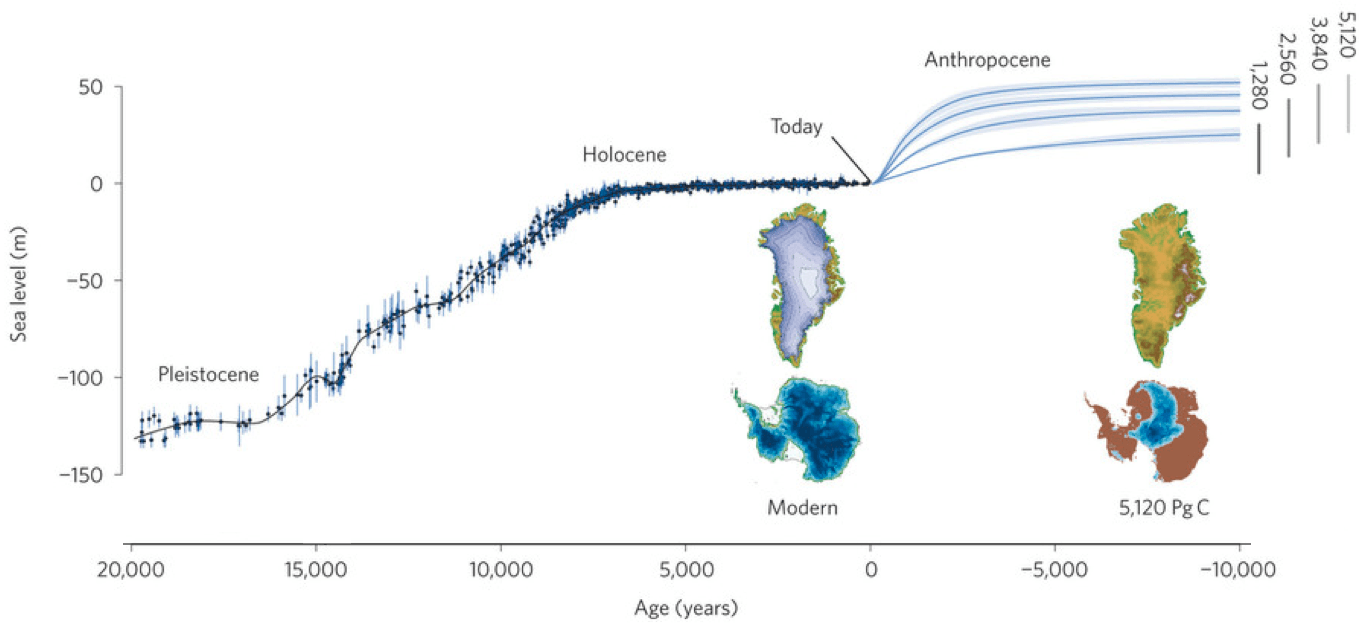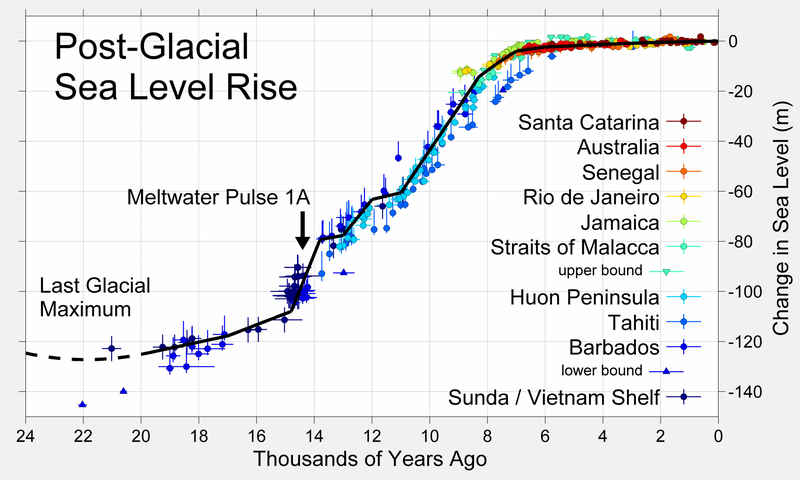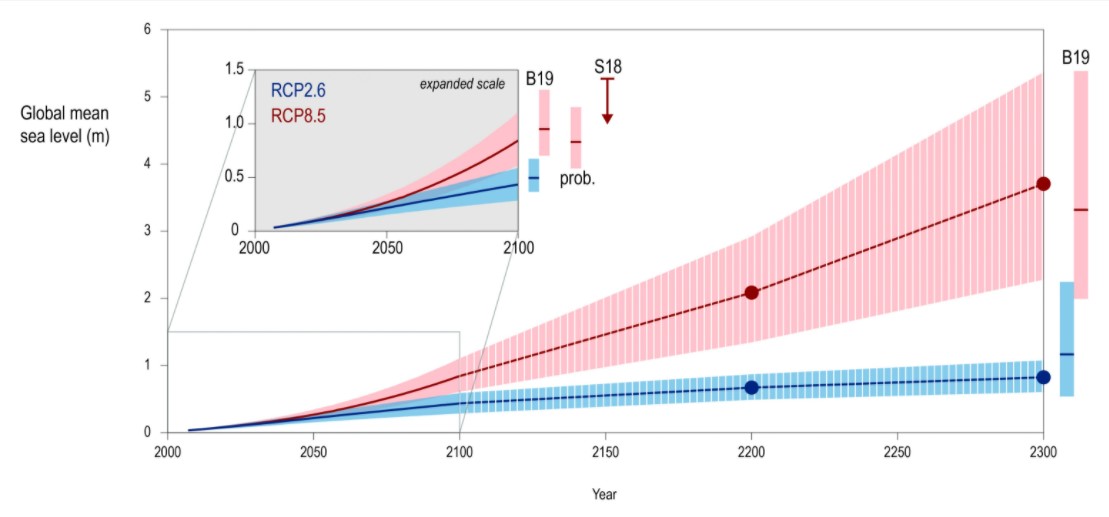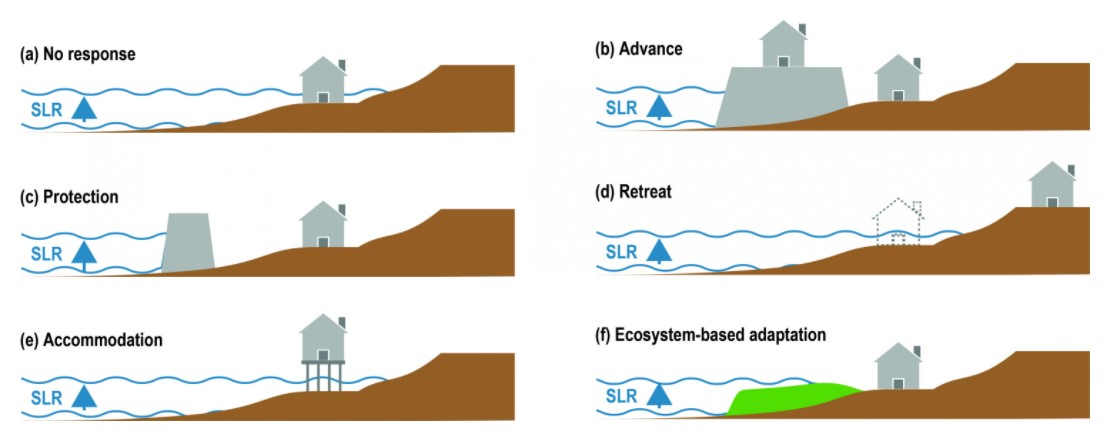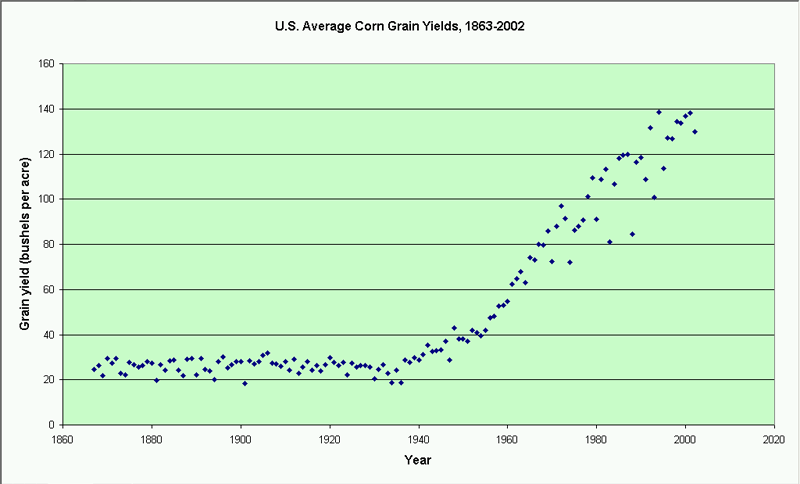Seven scientists analysed the article and estimate its overall scientific credibility to be ‘very low’. more about the credibility rating
A majority of reviewers tagged the article as: Flawed reasoning, Inaccurate, Misleading.
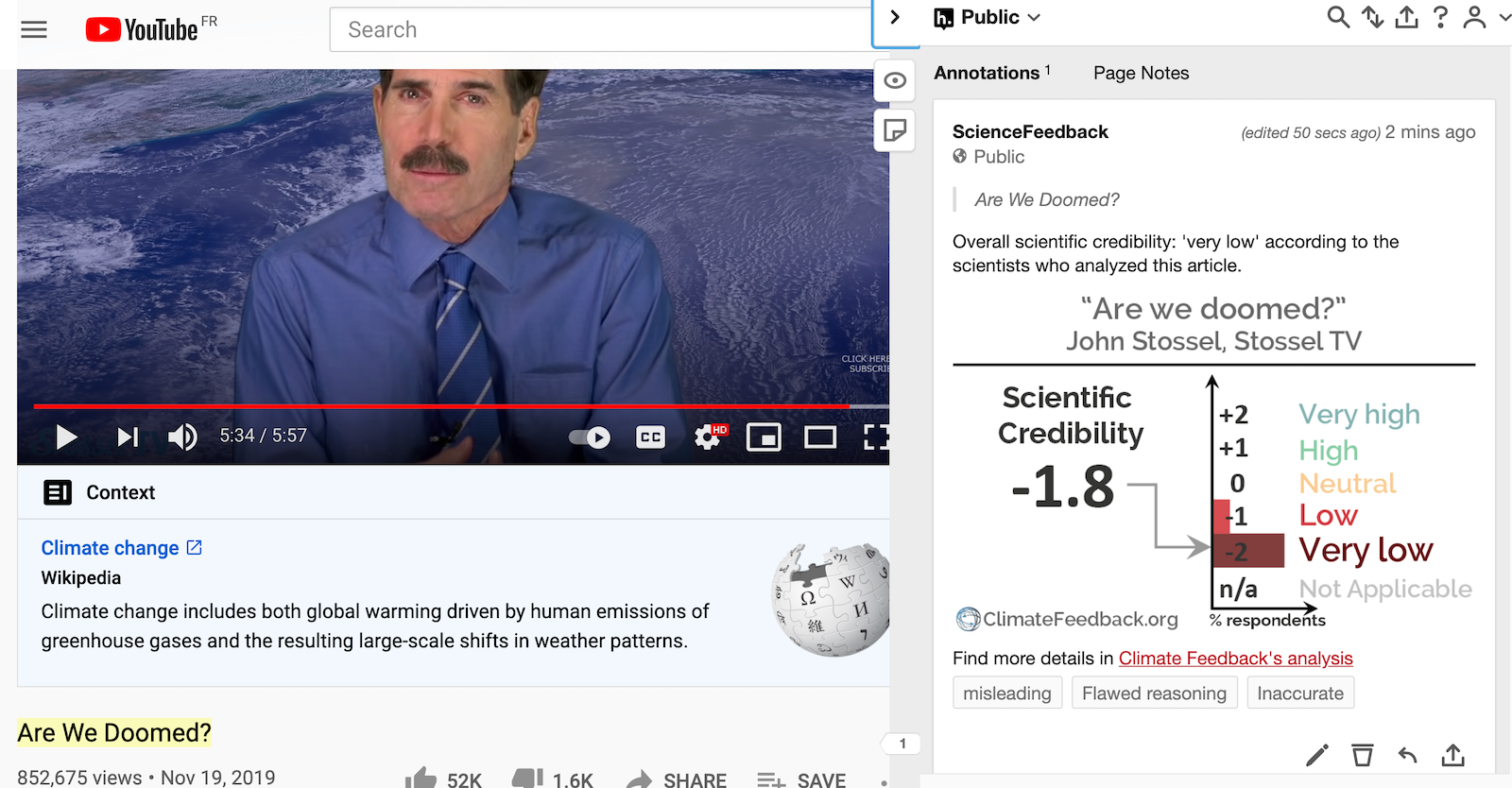
SUMMARY
The video was published by John Stossel on YouTube in November 2019 and reposted on Facebook in April 2021. The video comments on statements made about climate change by environmental activists and politicians that can be misleading. However, speakers in the video rely on several inaccurate claims and use imprecise language that misleads viewers about the scientific understanding of climate change, according to scientists who reviewed the video.
For instance, the claim that sea levels have been rising for 20,000 years, made by David Legates, a Professor and former assistant secretary of commerce for NOAA nominated by the Trump administration, is imprecise and misleading, as it implies sea levels have continued rising since then and current sea level rise is just a continuation of past natural fluctuations. But the causes of the global warming event that explains sea level rise at the end of the last ice age 20,000 years ago are different from those that explain sea level rise now. In the last 6,000 years, global sea level was stable (see figure 1 below). Ocean volumes remained nearly constant until an increase in the rate of sea-level rise 100–150 years ago, with no oscillations in global sea level exceeding ∼15–20 cm from 6,000 to 150 years before present[1].
Figure 1—Long-term global mean sea-level change for the past 20,000 years (black line) based on paleo sea level records and projections for the next 10,000 years for four emission scenarios. From this Climate Feedback review.
In the video, Patrick Michaels, a former professor of environmental sciences at the University of Virginia, claims that „hurricanes and other storms“ are not „getting worse“ and that „there is no relationship between hurricane activity and the surface temperature of the planet“. But what does science tell us about how global warming might affect hurricanes? Research shows that climate scientists don’t necessarily expect an increase in the frequency of all hurricanes with global warming, but instead an increase in hurricane risk. Specifically, scientists expect that „sea level rise accompanying the warming will lead to higher storm inundation levels“ and that the global proportion of hurricanes that reach very intense (category 4–5) levels will increase, as described in Knutson et al. (2020)[2,3]. Scientists also expect increased precipitation rates in hurricanes[4].
Kerry Emanuel, Professor at the Massachusetts Institute of Technology who has extensively studied hurricanes intensity, indicates that indeed „the most up-to-date research…demonstrates an increase in the proportion of hurricanes that become major hurricanes (Category 3-5) globally“[3] (read his full comment below). In the video, Michaels misleads viewers by cherry-picking a single measure of hurricane activity and ignoring the broader corpus of scientific research that demonstrates the expected increase in risks related to hurricanes.
Another claim Stossel makes in the video is that CO2 doesn’t harm or threaten the food supply because it helps plants grow faster and that CO2 “helps feed the world”. This claim also relies on cherry-picking some effects of CO2 on plants, while completely ignoring others. Climate Feedback previously evaluated this claim and found it to be misleading (see here and here). Like other nutrients, CO2 is necessary for plant growth and increased levels of atmospheric CO2 have led to vegetative greening in some regions of the world. However, to assess the overall impact of human CO2 emissions on agriculture, one cannot solely consider the effects of increased atmospheric CO2 concentrations on plant growth. Instead, one must evaluate all of the effects of increased CO2 and climate change on plants, since the Earth is not a controlled greenhouse environment.
As explained below by Sara Vicca, a postdoctoral research fellow at the University of Antwerp, elevated CO2 levels warm the planet, thereby generating a cascade of effects, including altered precipitation patterns and more frequent and intense extreme weather events such as heatwaves and droughts. Climate change can also increase heat stress, water stress, and pest prevalence, which can reduce crop yields[5]. Thus all these effects of climate change threaten global water and food supplies[5-8].
As Patrick Brown, assistant professor at San Jose State University, and Kristie Ebi, professor at the University of Washington, describe below, higher CO2 concentrations also reduce the nutrient density of major cereal crops[5], which runs counter to the simplistic view presented in Stossel’s video that CO2 “helps feed the world” (read on for details).
In the video, Stossel complains that scientists don’t want to debate with him; however, this is not how scientific debate works. Scientific debate doesn’t primarily happen on YouTube videos or social media platforms, or through discussions between scientists and news commentators. Instead, researchers who engage in a scientific debate traditionally do so by submitting articles to academic journals. These articles present the evidence and data they have gathered to support a particular claim. These claims must stand up to scrutiny by other scientists, who evaluate the new evidence in the context of previous studies and can attempt to replicate the work or confirm or reject the results by other means. In contrast, except for rare exceptions, climate contrarian bloggers don’t conduct their own research or submit properly written accounts of their findings to academic journals, eschewing the peer review process.
REVIEWERS’ OVERALL FEEDBACK
These comments are the overall assessment of scientists on the article, they are substantiated by their knowledge in the field and by the content of the analysis in the annotations on the article.
Andrew King, Research fellow, University of Melbourne:
This video is misleading in so many ways it’s hard to know where to begin. For a start there’s a repeated assertion that climate „alarmists“ won’t enter debate on climate change, but there are many examples of renowned climate scientists such as Gavin Schmidt, Michael Mann and David Karoly entering into debates with climate change denialists. Many scientists have found such debates to be unhelpful as they give the false impression of balance despite there being broad consensus among climate scientists that human greenhouse gas emissions have caused at least 1°C of global warming to date. In these debates, climate denialists recycle the same flawed arguments even though they have been debunked many times (see here).
On the issue of being able to adapt to 5°C of global warming, while humans are resilient to some change, we know that, especially in the developing world, capacity to adapt to climate change is limited. A slew of recent studies has demonstrated that even at 2°C of global warming the impacts of climate change would be pervasive and devastating. Many studies show that severe heatwaves, which already kill many thousands of people in the current climate, would become much more deadly even with relatively little additional global warming, let alone 5°C of warming (for example, Saeed et al. (2021)[9].
In order to adapt to global warming humans require that the planet’s ecosystems also survive, but with only another 1°C of global warming the vast majority of the world’s coral reefs would be damaged beyond recognition[10]. Severe heat-induced bleaching and ocean acidification, both of which are linked to human-induced climate change, are damaging the world’s reefs already[11]. Hundreds of millions of people globally rely on there being healthy coral reefs[12], but even beyond 1.5°C global warming the survival of the world’s reefs is at threat. There are many, many other ways in which going beyond another 1°C of global warming would be extremely damaging, including extreme and continued sea level rise[13], and the increased possibility of triggering major disruptions to the Earth system with irreversible consequences (for example, this Nature article). The notion that society could adapt to, or even thrive, at 5°C of global warming is fanciful.
Misinformation that masks the threats that global climate change poses has the potential to slow down our efforts to tackle this problem. It is vital that society is guided by the science and acts to reduce greenhouse gas emissions so future generations don’t pay the price.
Timothy Osborn, Professor, University of East Anglia, and Director of Research, Climatic Research Unit:
This video has little scientific credibility. It builds up false strawmen about climate change and then pretends to demolish them with flawed reasoning and cherry-picked statements. Here are some examples:
1. The suggestion that the evidence for climate change is not being debated is false — evidence is continually being weighed up during the research process and in scientific publications and then in scientific assessment processes such as the IPCC.
2. The claim that sea levels have been rising for 20,000 years is false. It is likely that sea levels fell slightly over the last 2,000 years until the last century when they began rising and have recently accelerated. See Barnett et al. (2019)[14].
3. The claim that because Netherlands have reduced coastal flooding means that the world could simply adapt to a global temperature rise of 5 degrees Celsius has no support at all. There is ample evidence for the colossal impacts that such an unprecedented rate of climate change would have and the evidence is that it would be overwhelmingly damaging. The evidence is summarised in the IPCC’s ‚reasons for concern‘[15].
Victor Venema, Scientist, University of Bonn, Germany:
The video is mostly innuendo, tossed together with incorrect and misleading claims and impossible expectations. A clear example of a misleading statement is describing the figure below as „the water has been rising for approximately 20,000 years“, while until recently the sea level in the age we built our infrastructure was remarkably stable (see figure 2).
Figure 2—Created by Robert A. Rohde from published data and incorporated into the Global Warming Art project.
ANNOTATIONS
The statements quoted below are from the video; comments are from the reviewers (and are lightly edited for clarity).
Claim: “Even if the planet warmed by 5 degrees, humans can adjust. People in Holland did… Are you telling me that people in Miami are so dumb that they are just going to sit there and drown?” … “the water has been rising for approximately 20,000 years and probably will continue” “but we can adapt, like Holland has.”
Benjamin Horton, Professor, Earth Observatory of Singapore:
[Comment from a previous evaluation of a similar claim]
False. Comparison of long tide gauge records and multi-centennial to millennial scale sea-level reconstructions from the same region indicates that the rate of rise during the instrumental period (since ~1850 CE) was significantly faster than it was during the late Holocene (the 4000–2000 years prior to ~1850 CE). The data demonstrate that an acceleration in the rate of sea-level rise occurred[16].
Patrick Brown, Postdoctoral Research Scientist, Carnegie Institution for Science:
From approximately 20,000 years ago to approximately 4,000 years ago, there was a very large rise in sea level (approximately 125 meters or 410 feet) that occurred as the Earth emerged from the last glacial maximum (due to orbital changes). The fact that this occurred is largely irrelevant to the question of how much disruption multi-meter sea level rise (See figure below from Oppenheimer et al., 2019)[17] over the next several centuries will inflict on our current society.
It is of course the case that various adaptation options are on the table (see figure below from Oppenheimer et al., 2019)[17].
The appropriate question is whether it costs more (in the broadest sense of the word cost) to reduce CO2 emissions or by continuing to emit indefinitely and choosing only adaptation. There are sufficient fossil fuels available to completely melt the Greenland and Antarctica ice sheets and raise global sea levels approximately 60 meters or 200 feet[18]. This would represent an astronomical cost much larger than the cost to transition to a near-zero emissions energy system[19]. Thus, relying 100% on adaptation fails the cost-benefit test in the long term.
Claim: “the alarmists say hurricanes and other storms are getting worse. No they aren’t. You can take a look at all the hurricanes around the planet, we can see them since 1970 thanks to global satellite coverage and we can measure their power and we can add up their power. And there is no significant increase whatsoever. There is no relationship between hurricane activity and the surface temperature of the planet.”
Kerry Emanuel, Professor of Atmospheric Science, MIT:
The most up-to-date research published in the Proceedings of the National Academy of Sciences demonstrates an increase in the proportion of hurricanes that become major hurricanes (Category 3-5) globally, supporting theoretical predictions that date back to 1987 (see figure below)[3].
As explained in a previous review, the latest consensus papers published in 2019 by Knutson et al. show a strong consensus that tropical cyclones will become more intense (but not necessarily more frequent) as the climate warms[2]. There is also a unanimous consensus that tropical cyclones will produce more rain, and in places with sufficient rain measurements, there is strong evidence for heavier rain events[2].
Figure 3—The proportion of major hurricane intensities to all hurricane intensities globally from 1979-2017. Data is binned into 3-year periods. The proportion of global major hurricanes increased by 25% over the 39-year time period analyzed. From Kossin et al. (2020)[4].
Patrick Brown, Postdoctoral Research Scientist, Carnegie Institution for Science:
While there are no substantial trends in the global frequency of total hurricanes, major hurricanes or accumulated cyclone energy over the past few decades[20], it would be premature to say that there is no relationship between global mean surface temperature and global hurricane activity (broadly defined). For instance, know that there is a stronger relationship between surface temperature and hurricane rain rates than there is between surface temperature and hurricane wind speeds.
The IPCC 2019 summarizes hurricane (or tropical cyclone, TC) projections going forward in the following paragraph:
“Tropical cyclones (TCs) projections for the late 21st century are summarised as follows: 1) there is medium confidence that the proportion of TCs that reach Category 4-5 levels will increase, that the average intensity of TCs will increase (by roughly 1-10%, assuming a 2°C global temperature rise), and that average TCs precipitation rates (for a given storm) will increase by at least 7% per degree Celsius of sea surface temperature warming, owing to higher atmospheric water vapour content, 2) there is low confidence in how global TC frequency will change, although most modelling studies project some decrease in global TC frequency and 3) sea level rise will lead to higher storm surge levels for the TCs that do occur, assuming all other factors are unchanged (very high confidence).”[21]
Claim: ”The Obama administration’s model projects that the amount of global warming that would be saved if we were going to go to zero emissions tomorrow (which would put us back to the stone age) would be 0.14°C. So no real effect on the climate.”
Patrick Brown, Postdoctoral Research Scientist, Carnegie Institution for Science:
This is a number corresponding to the United States acting in isolation. The United States currently represents about 14% of annual new CO2 emissions. So of course, eliminating only that portion of emissions will not solve the problem.
However, if all the governments in the world were to act in coordination to bring emissions down to near zero, then global temperatures will stop increasing. The amount of global warming avoided from going to zero emissions globally (compared to burning all fossil fuels) is closer to 8 degrees Celsius which equates to approximately 22 degrees Fahrenheit over land. So global programs to limit emissions make an enormous difference.
This is exactly why this process is mediated through entities like the United Nations – because it is a collective action problem that requires international cooperation.
Claim: “The idea of carbon dioxide being pollution that just does harm and threatens the food supply is a myth. If you are really concerned about the plants, more carbon dioxide makes them not just grow faster but also makes them more water efficient. CO2 is a greenhouse gas but it also helps feed the world.”
Sara Vicca, Postdoctoral research fellow, University of Antwerp:
The claim is misleading. Plants need CO2 to grow and they often grow better when the CO2 concentration increases. However, this fact is often abused to claim that increasing CO2 concentrations is mainly positive, while it also has several adverse effects. Increasing CO2 causes ocean acidification, which negatively affects marine life and threatens to disrupt the marine food web. And of course elevated CO2 warms the planet, thereby generating a cascade of effects from melting of glaciers and sea level rise to altered precipitation patterns and increasing frequency and intensity of extreme weather events such as heatwaves and droughts. These in turn threaten water and food supplies, and as climate change progresses, this is also likely to undo much of the beneficial effect that CO2 has on plant growth[5-8].
Patrick Brown, Postdoctoral Research Scientist, Carnegie Institution for Science:
It is true that increases in atmospheric CO2 make photosynthesis more efficient and have resulted in ‘greening’ trends observable from space. See, for example, the IPCC statement below[7].
“Globally, greening trends have increased over the last 2-3 decades by 22-33%, particularly over China, India, many parts of Europe, central North America, southeast Brazil and southeast Australia (high confidence). This results from a combination of direct and indirect factors (i.e. CO2, fertilisation, extended growing season, nitrogen deposition […])”
However, this CO2 fertilization effect is just one of a myriad of influences on crop productivity and quality. Global crop models take into account many potential changes (including the fertilization effect from CO2) and tend to indicate that the net effect of increased CO2 (including its climate affects) will cause yields to decrease[5]:
“At the global scale, Iizumi et al. (2018) used a counterfactual analysis and found that climate change between 1981 and 2010 has decreased global mean yields of maize, wheat, and soybeans by 4.1, 1.8 and 4.5%, respectively, relative to preindustrial climate, even when CO2 fertilisation and agronomix adjustments are considered.”[22]
Also, increased atmospheric CO2 tends to decrease the nutritional quality of crops[5,22].
Kristie Ebi, Professor, University of Washington:
Higher CO2 concentrations reduce the nutrient density of major cereal crops, including wheat and rice. At CO2 concentrations expected later this century, protein declines about 10%, micronutrients about 5%, and B-vitamins about 30%[23]. This matters because there are more than 2 billion people worldwide with micronutrient deficiencies (Micronutrient Deficiency – Our World in Data). This is significantly higher than the numbers of people who are food insecure. Estimates of the numbers of people potentially affected are in the hundreds of millions.
[The idea that increased CO2 so far is helping feed the world is an exaggeration as explained by Professor Philip Robertson in a previous review:]
G Philip Robertson, Professor, Michigan State University:
In general, CO2 has had a positive effect on crop growth, but it’s impossible to separate historical effects from the greater effects of genetics and nitrogen and other inputs. However, it’s generally considered to be a fraction of those. We know better future effects because we have CO2 fertilization experiments in the field comparing present to future CO2 levels. Those experiments suggest that corn may have about a 1% gain [because of increased CO2] and soybeans 3-4 times that. However, these gains will almost certainly be offset by yield declines associated with the temperature increases caused by elevated CO2, which are well known.
Historically, it’s worth noting that we had elevated CO2 long before we had the green revolution, and crop yields didn’t increase much until the green revolution. You can see this in graphs of average US corn yields from 1900.
Source: University of Nebraska-Lincoln
Claim: “It is not the case that we “have twelve years to act”
Patrick Brown, Postdoctoral Research Scientist, Carnegie Institution for Science:
I agree with the sentiment that there is very weak evidence that crossing 1.5°C represents some unique tipping point into catastrophe.
This claim is made in regards to a 2018 Intergovernmental Panel on Climate Change report[24]. That report was on the impacts associated with global warming of 1.5°C (2.7°F) above preindustrial levels as well as the technical feasibility of limiting global warming to such a level. In 2018, the year 2030 was 12 years away and 2030 was deemed the earliest year in which the 1.5°C threshold could be crossed.
The media coverage of the report did often portray it as saying we have 12 years (until 2030) to act on climate else catastrophe would ensue but the report did not actually make such claims.
The report was not tasked with defining a level of global warming which might be considered to be catastrophic (or any other alarming adjective). Rather, the report was tasked with evaluating the impacts of global warming of 1.5°C (2.7°F) above preindustrial levels, and comparing these to the impacts associated with 2.0°C (3.6°F) above preindustrial levels as well as evaluating the changes to global energy systems that would be necessary in order to limit global warming to 1.5°C.
To summarize, the IPCC’s literature review found that impacts of global warming at 2.0°C are worse than at 1.5°C[24]. There was no claim by the IPCC that we have 12 years to avoid catastrophe. Therefore, I do not take issue with the Facebook video portraying this framing as a myth.
REFERENCES:
- 1 – Lambeck et al. (2014) Sea level and global ice volumes from the Last Glacial Maximum to the Holocene. PNAS.
- 2 – Knutson et al. (2020) Tropical Cyclones and Climate Change Assessment: Part II: Projected Response to Anthropogenic Warming. Bulletin of the American Meteorological Society.
- 3 – Kossin et al. (2020) Global increase in major tropical cyclone exceedance probability over the past four decades. PNAS.
- 4 – Liu et al. (2019) Causes of large projected increases in hurricane precipitation rates with global warming. npj Climate and Atmospheric Science.
- 5 – Moore et al. (2017) New science of climate change impacts on agriculture implies higher social cost of carbon. Nature.
- 6 – Terrier et al. (2019) Nitrogen and phosphorus constrain the CO2 fertilization of global plant biomass. Nature Climate Change.
- 7 – Shukla et al. (2019) Technical Summary, 2019. In: Climate Change and Land: an IPCC special report on climate change, desertification, land degradation, sustainable land management, food security, and greenhouse gas fluxes in terrestrial ecosystems. IPCC report.
- 8 – Mbow et al. (2019) IP Food Security. In: Climate Change and Land: an IPCC special report on climate change, desertification, land degradation, sustainable land management, food security, and greenhouse gas fluxes in terrestrial ecosystems. IPCC report.
- 9 – Saheed et al. (2021) Deadly Heat Stress to Become Commonplace Across South Asia Already at 1.5°C of Global Warming. Geophysical Research Letters.
- 10 – Hughes et al. (2017) Coral reefs in the Anthropocene. Nature.
- 11 – Hughes et al. (2017) Global warming and recurrent mass bleaching of corals. Nature.
- 12 – Pendleton et al. (2016) Coral Reefs and People in a High-CO2 World: Where Can Science Make a Difference to People? Plos One.
- 13 – Nauels et al. (2019) Attributing long-term sea-level rise to Paris Agreement emission pledges. PNAS.
- 14 – Barnett et al. Late Holocene sea level. Past Global Changes.
- 15 – O’Neill et al. (2017) IPCC reasons for concern regarding climate change risks. Nature Climate Change.
- 16 – Kopp et al (2016) Temperature-driven global sea-level variability in the Common Era. PNAS.
- 17 – Oppenheimer et al. (2019) Sea Level Rise and Implications for Low-Lying Islands, Coasts and Communities. In: IPCC Special Report on the Ocean and Cryosphere in a Changing Climate.
- 18 – Winkelmann et al. (2015) Combustion of available fossil fuel resources sufficient to eliminate the Antarctic Ice Sheet. Science Advances.
- 19 – Brown et al. (2020) Break-even year: a concept for understanding intergenerational trade-offs in climate change mitigation policy. Environmental Research Communications.
- 20 – Blunden and Arndt (2020) State of the Climate in 2019. Bulletin of the American Meteorological Society.
- 21 – IPCC (2019) Technical Summary. In: IPCC Special Report on the Ocean and Cryosphere in a Changing Climate.
- 22 – Iizumi et al. (2018) Crop production losses associated with anthropogenic climate change for 1981–2010 compared with preindustrial levels. International Journal of Climatology.
- 23 – Zhu et al. (2018) Carbon dioxide (CO2) levels this century will alter the protein, micronutrients, and vitamin content of rice grains with potential health consequences for the poorest rice-dependent countries. Science Advances.
- 24 – IPCC (2018) Summary for Policymakers. In: Global Warming of 1.5°C. An IPCC Special Report on the impacts of global warming of 1.5°C above pre-industrial levels and related global greenhouse gas emission pathways, in the context of strengthening the global response to the threat of climate change, sustainable development, and efforts to eradicate poverty. World Meteorological Organization.

